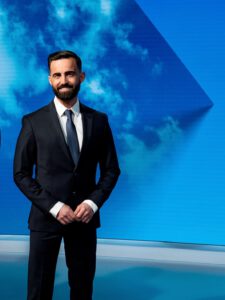Interview | Darijo Brzoja – Towards clean air in Zagreb, Croatia
 Darijo Brzoja is the head of air quality modelling at the Croatian Meteorological and Hydrological Service in Zagreb. He is involved in the European LIFE CityTRAQ project, which aims to improve local air quality in Zagreb using information from traffic counts and air quality measurements.
Darijo Brzoja is the head of air quality modelling at the Croatian Meteorological and Hydrological Service in Zagreb. He is involved in the European LIFE CityTRAQ project, which aims to improve local air quality in Zagreb using information from traffic counts and air quality measurements.
In this interview, we delve into CityTRAQ, a European project focusing on urban air quality. Can you tell us more about the project?
Our role in the project focuses on air quality in our capital, Zagreb. We aim to transfer knowledge and lessons from pilot projects in Flemish cities to the capital. We will set up sensors in the city to identify air pollution hotspots. Since Zagreb does not conduct traffic counts, we need to enhance our emission inventory in the city. We will try to introduce new data to feed the tools developed in Belgium. We want to investigate the current air quality situation in Zagreb and then explore scenarios to improve air quality.
The project is in its second year. Are there any updates? Have you noticed anything specific?
At the moment, we have not collected new data. We are exploring which existing data can be used in the project. The first year was relatively quiet from an action perspective on our part. Our focus was on listening and learning, which is normal for the initial phase of such a project, emphasizing thorough preparation. Flemish cities are still figuring out the right sensors, so we are considering how to prepare for the next year. That is the intention, as we are the city in this project that will need to ‘copy’ the methodology.
The project has a dual purpose: there is a screening tool and a scenario tool. What are they, and how will you use them?
The screening tool detects how air pollution is distributed across the city —it is purely a detection tool. The scenario tool is for organizations unfamiliar with monitoring, allowing them to simulate scenarios easily and quickly. This helps them determine actions to improve air quality. The first step is always to use the screening tool to identify air quality issues in the city. Then, the scenario tool can be applied, not only for air quality but also for other policies and possibly other areas such as climate change. Different parts of the city must collaborate to determine future possibilities.
Is that the second part of the project?
Actually, it’s the final part.
What do you personally contribute to the project?
I lead the project from Zagreb, organizing tasks for my colleagues and monitoring the project’s progress with partner cities. I attend many meetings and use my professional expertise to assist in data collection in the city.
When is the project a success for you?
Currently, all action points are set. Our initial step is to purchase samplers and install them in different parts of the city to determine areas with high or low air pollution. One of our crucial action points is collecting better traffic data. In Zagreb, and in other cities in Croatia, we lack data on city traffic. We have data on highways and around cities but not within the cities themselves. So, it’s a small success for us if we can model air quality in the city. Afterward, we will install air quality sensors in the city. Since we have no experimental knowledge about these sensors, only knowledge from the literature, we need to learn how they work. It would be very instructive if we could place some of these sensors next to our professional air quality sites to compare the results. Ultimately, if we can set up the screening and scenario tools, feeding them with new data and results, we can present concrete issues to the Zagreb city government, making it easy for them to take action to improve air quality. After that, there are, of course, other cities in Croatia where we can spread knowledge and news.
So, this is just the beginning…
Yes, we are also starting new projects that overlap with this one. So, CityTRAQ is, so to speak, a pilot project for something even larger.
And how did the collaboration come about? Because it’s a bit of a peculiar combination, Flemish cities and Zagreb.
It is quite normal when working in the field and attending various conferences. We are part of the forum for air quality modelling within GRC. We had a large air quality monitoring project where we collaborated with VITO. I was contacted by them when VMM initiated this project. They told me they were looking for a city to transfer knowledge to and asked if we were willing to join the project. And it was successful. That’s usually how these things go: you meet people, they remember who you are, and then you join a new project. In this way, I have met many fantastic people, both at VMM and in partner cities. It’s a great collaboration, and we all work towards the same goal. Air knows no boundaries; it’s everywhere. So, I am very happy to be part of this project, to strengthen relationships, and to work towards a shared goal of clean air throughout Europe. It’s great to work in this field!
